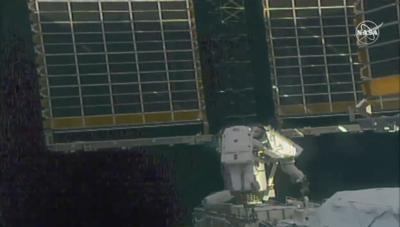Sat, Jun 19, 2021
Astro's Still Need To Install Electrical Cables And Drive The Final Two Bolts To Enable The Solar Array To Unfurl
NASA astronaut Shane Kimbrough and ESA (European Space Agency) astronaut Thomas Pesquet concluded their spacewalk at 3:26 p.m. EDT, Wednesday, after 7 hours and 15 minutes. In the seventh spacewalk of the year outside the International Space Station, the two astronauts installed a new ISS Roll-Out Solar Array (iROSA) into its mounting bracket on the far end of the left (port) side of the station’s backbone truss structure (P6).

Kimbrough and Pesquet successfully removed the array from its position in the flight support equipment and maneuvered it into position on the mast canister at the 2B power channel.
Before the new array can be deployed and begin providing power to the orbiting laboratory, spacewalkers will need to install the electrical cables and drive the final two bolts to enable the solar array to unfurl its fully deployed position. Pesquet and Kimbrough are scheduled for another spacewalk coming up on Sunday, June 20 to continue the installation of new solar arrays.
NASA is augmenting six of the eight existing power channels of the space station with new solar arrays to ensure a sufficient power supply is maintained for NASA’s exploration technology demonstrations for Artemis and beyond as well as utilization and commercialization.
This was the seventh spacewalk for Kimbrough, the third for Pesquet, and the third they conducted together. Kimbrough has now spent a total of 46 hours and 15 minutes spacewalking, and Pesquet’s total spacewalking time is 19 hours and 47 minutes.
Space station crew members have conducted 239 spacewalks in support of assembly and maintenance of the orbiting laboratory. Spacewalkers have now spent a total of 62 days, 18 hours, and 28 minutes working outside the station.
In November 2020, the International Space Station surpassed its 20-year milestone of continuous human presence, providing opportunities for unique research and technological demonstrations that help prepare for long-duration missions to the Moon and Mars and also improve life on Earth. In that time, 244 people from 19 countries have visited the orbiting laboratory that has hosted nearly 3,000 research investigations from researchers in 108 countries and areas.
More News
A Puff Of Smoke Came Out From The Top Of The Engine Cowling Followed By A Total Loss Of Engine Power On May 9, 2025, about 1020 mountain daylight time, an experimental amateur-buil>[...]
From 2022 (YouTube Edition): Jenny, I’ve Got Your Number... Among the magnificent antique aircraft on display at EAA’s AirVenture 2022 was a 1918 Curtiss Jenny painstak>[...]
Very High Frequency (VHF) The frequency band between 30 and 300 MHz. Portions of this band, 108 to 118 MHz, are used for certain NAVAIDs; 118 to 136 MHz are used for civil air/grou>[...]
“From approximately November 2021 through January 2022, Britton-Harr, acting on behalf of AeroVanti, entered into lease-purchase agreements for five Piaggio-manufactured airc>[...]
Microburst A small downburst with outbursts of damaging winds extending 2.5 miles or less. In spite of its small horizontal scale, an intense microburst could induce wind speeds as>[...]
 NTSB Prelim: Lee Aviation LLC JA30 SuperStol
NTSB Prelim: Lee Aviation LLC JA30 SuperStol Classic Aero-TV: Curtiss Jenny Build Wows AirVenture Crowds
Classic Aero-TV: Curtiss Jenny Build Wows AirVenture Crowds ANN's Daily Aero-Term (05.30.25): Very High Frequency (VHF)
ANN's Daily Aero-Term (05.30.25): Very High Frequency (VHF) Aero-News: Quote of the Day (05.30.25)
Aero-News: Quote of the Day (05.30.25) ANN's Daily Aero-Term (05.31.25): Microburst
ANN's Daily Aero-Term (05.31.25): Microburst



